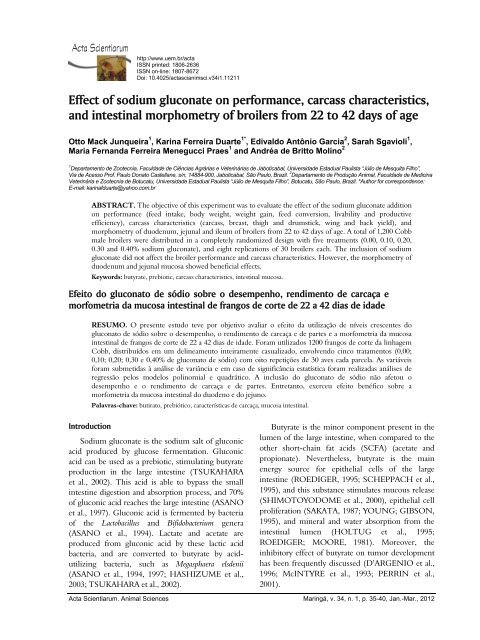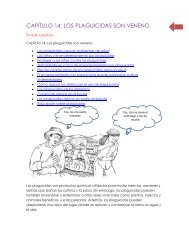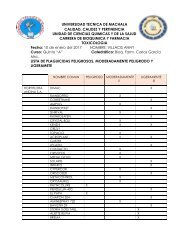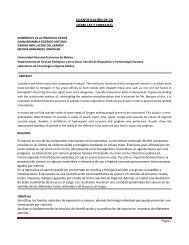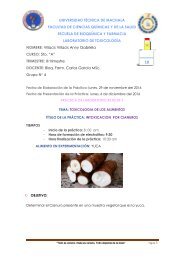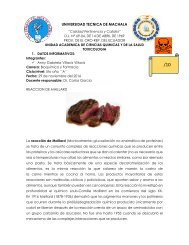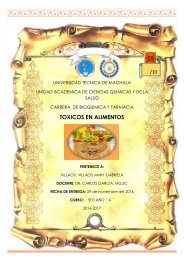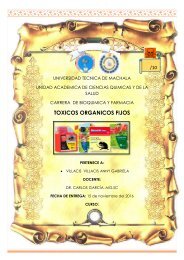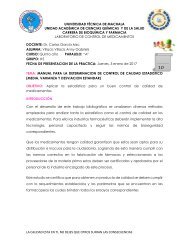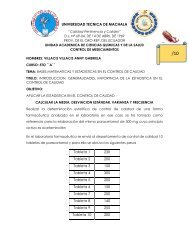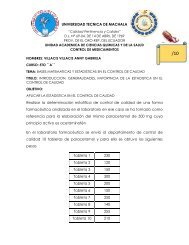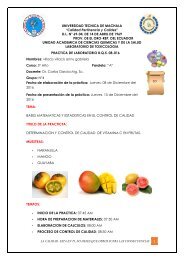Create successful ePaper yourself
Turn your PDF publications into a flip-book with our unique Google optimized e-Paper software.
Acta Scientiarum<br />
http://www.uem.br/acta<br />
ISSN printed: 1806-2636<br />
ISSN on-line: 1807-8672<br />
Doi: 10.4025/actascianimsci.v34i1.11211<br />
Effect of sodium gluconate on performance, carcass characteristics,<br />
and intestinal morphometry of broilers from 22 to 42 days of age<br />
Otto Mack Junqueira 1 , Karina Ferreira Duarte 1* , Edivaldo Antônio Garcia 2 , Sarah Sgavioli 1 ,<br />
Maria Fernanda Ferreira Menegucci Praes 1 and Andréa de Britto Molino 2<br />
1 Departamento de Zootecnia, Faculdade de Ciências Agrárias e Veterinárias de Jaboticabal, Universidade Estadual Paulista “Júlio de Mesquita Filho”,<br />
Via de Acesso Prof. Paulo Donato Castellane, s/n, 14884-900, Jaboticabal, São Paulo, Brazil. 2 Departamento de Produção Animal, Faculdade de Medicina<br />
Veterinária e Zootecnia de Botucatu, Universidade Estadual Paulista “Júlio de Mesquita Filho”, Botucatu, São Paulo, Brazil. *Author for correspondence:<br />
E-mail: karinafduarte@yahoo.com.br<br />
ABSTRACT. The objective of this experiment was to evaluate the effect of the sodium gluconate addition<br />
on performance (feed intake, body weight, weight gain, feed conversion, livability and productive<br />
efficiency), carcass characteristics (carcass, breast, thigh and drumstick, wing and back yield), and<br />
morphometry of duodenum, jejunal and ileum of broilers from 22 to 42 days of age. A total of 1,200 Cobb<br />
male broilers were distributed in a completely randomized design with five treatments (0.00, 0.10, 0.20,<br />
0.30 and 0.40% sodium gluconate), and eight replications of 30 broilers each. The inclusion of sodium<br />
gluconate did not affect the broiler performance and carcass characteristics. However, the morphometry of<br />
duodenum and jejunal mucosa showed beneficial effects.<br />
Keywords: butyrate, prebiotic, carcass characteristics, intestinal mucosa.<br />
Efeito do gluconato de sódio sobre o desempenho, rendimento de carcaça e<br />
morfometria da mucosa intestinal de frangos de corte de 22 a 42 dias de idade<br />
RESUMO. O presente estudo teve por objetivo avaliar o efeito da utilização de níveis crescentes do<br />
gluconato de sódio sobre o desempenho, o rendimento de carcaça e de partes e a morfometria da mucosa<br />
intestinal de frangos de corte de 22 a 42 dias de idade. Foram utilizados 1200 frangos de corte da linhagem<br />
Cobb, distribuídos em um delineamento inteiramente casualizado, envolvendo cinco tratamentos (0,00;<br />
0,10; 0,20; 0,30 e 0,40% de gluconato de sódio) com oito repetições de 30 aves cada parcela. As variáveis<br />
foram submetidas à análise de variância e em caso de significância estatística foram realizadas análises de<br />
regressão pelos modelos polinomial e quadrático. A inclusão do gluconato de sódio não afetou o<br />
desempenho e o rendimento de carcaça e de partes. Entretanto, exerceu efeito benéfico sobre a<br />
morfometria da mucosa intestinal do duodeno e do jejuno.<br />
Palavras-chave: butirato, prebiótico, características de carcaça, mucosa intestinal.<br />
Introduction<br />
Sodium gluconate is the sodium salt of gluconic<br />
acid produced by glucose fermentation. Gluconic<br />
acid can be used as a prebiotic, stimulating butyrate<br />
production in the large intestine (TSUKAHARA<br />
et al., 2002). This acid is able to bypass the small<br />
intestine digestion and absorption process, and 70%<br />
of gluconic acid reaches the large intestine (ASANO<br />
et al., 1997). Gluconic acid is fermented by bacteria<br />
of the Lactobacillus and Bifidobacterium genera<br />
(ASANO et al., 1994). Lactate and acetate are<br />
produced from gluconic acid by these lactic acid<br />
bacteria, and are converted to butyrate by acidutilizing<br />
bacteria, such as Megasphaera elsdenii<br />
(ASANO et al., 1994, 1997; HASHIZUME et al.,<br />
2003; TSUKAHARA et al., 2002).<br />
Butyrate is the minor component present in the<br />
lumen of the large intestine, when compared to the<br />
other short-chain fat acids (SCFA) (acetate and<br />
propionate). Nevertheless, butyrate is the main<br />
energy source for epithelial cells of the large<br />
intestine (ROEDIGER, 1995; SCHEPPACH et al.,<br />
1995), and this substance stimulates mucous release<br />
(SHIMOTOYODOME et al., 2000), epithelial cell<br />
proliferation (SAKATA, 1987; YOUNG; GIBSON,<br />
1995), and mineral and water absorption from the<br />
intestinal lumen (HOLTUG et al., 1995;<br />
ROEDIGER; MOORE, 1981). Moreover, the<br />
inhibitory effect of butyrate on tumor development<br />
has been frequently discussed (D’ARGENIO et al.,<br />
1996; McINTYRE et al., 1993; PERRIN et al.,<br />
2001).<br />
Acta Scientiarum. Animal Sciences Maringá, v. 34, n. 1, p. 35-40, Jan.-Mar., 2012
36 Junqueira et al.<br />
Saccharides are non-digestible materials that<br />
reach the large intestine (CAMPBELL et al., 1997;<br />
GIBSON; ROBERFROID, 1995; KIRIYAMA et al.,<br />
1992; LE BLAY et al., 1999a and b; MORTENSEN<br />
et al., 1988; PIVA et al., 1996; RISLEY et al., 1992),<br />
but only certain saccharides are able to stimulate<br />
butyrate production at that location (CAMPBELL<br />
et al., 1997; LE BLAY et al., 1999a and b;<br />
MORTENSEN et al., 1988). Gluconic acid is<br />
fermented in the large intestine (ASANO et al.,<br />
1997), but the fermentation process induced by this<br />
acid has not been elucidated.<br />
Sodium gluconate is commonly used in human<br />
food industry as an acidifier, coagulant and carrier<br />
for mineral supplements (ASANO et al., 1994).<br />
Only two experiments have been performed to test<br />
the effects of sodium gluconate on broilers (GUO<br />
et al., 2009; RAFACZ-LIVINGSTON et al., 2005b),<br />
and the conclusion was that the addition of sodium<br />
gluconate in diet caused an increase in weight gain<br />
and tibia ash of starter broilers.<br />
The objective of this experiment was to evaluate<br />
the effect of sodium gluconate on performance (feed<br />
intake, body weight, weight gain, feed conversion,<br />
livability and productive efficiency), carcass<br />
characteristics (carcass, breast, thigh and drumstick,<br />
wing and back yield), and morphometry of<br />
duodenum, jejunum and ileum of broilers from 22<br />
to 42 days of age.<br />
Material and methods<br />
A total of 1,200 Cobb male broilers were housed<br />
from 1 day of age in a completely randomized<br />
design, with 5 treatments (5 levels of sodium<br />
gluconate: 0.00, 0.10, 0.20, 0.30, and 0.40%) and 8<br />
replications of 30 birds each. The broilers were<br />
vaccinated against Marek disease, Newcastle disease<br />
and Infectious Bronchitis at hatchery. The<br />
immunization against Gumboro and Newcastle<br />
diseases was done at 7 days of age, and the<br />
reinforcement against Gumboro disease at 14 days<br />
of age. The room temperature recorded during the<br />
experimental period was 27 ± 2.8ºC, and relative<br />
humidity was 78 ± 8.7%.<br />
Water and feed were provided ad libitum. Broilers<br />
were fed with common starter diet until 21 days of age,<br />
in accordance with the nutrient recommendations<br />
(3,005 kcal ME kg -1 and 21.6% of CP) of Rostagno<br />
et al. (2005). The broilers were weighed at 22 days of<br />
age, and then allocated according to weight in 40 boxes<br />
containing 30 birds each.<br />
The basal diet (Table 1) was formulated<br />
following Rostagno et al. (2005) recommendations.<br />
Broilers were housed over reused wood-shavings<br />
bedding to provide a sanitary challenge.<br />
Body weight and feed intake values were recorded.<br />
Weight gain, feed conversion, livability, and productive<br />
efficiency {PE = [Daily mean weight gain (g) x livability<br />
(%)] / (feed conversion x 10)} were calculated for each<br />
pen at 42 days of age. The yield evaluation was done<br />
using 8 broilers per replication selected at random.<br />
Table 1. Composition and nutritive values of basal diet.<br />
Ingredients %<br />
Corn 66.48<br />
Soybean meal 25.78<br />
Soybean oil 3.03<br />
Dicalcium phosphate 1.63<br />
Limestone 0.96<br />
L-Lysine-HCl (78%) 0.27<br />
DL-Methionine 0.20<br />
L-Threonine 0.11<br />
L- Arginine 0.06<br />
L-Valine 0.09<br />
L-Isoleucine 0.05<br />
Vitamin and mineral premix 1 0.50<br />
Salt 0.44<br />
Variable portion (sand) 2 0.40<br />
Total 100.00<br />
Calculated nutrients<br />
CP (%) 17.76<br />
ME (kcal kg -1 ) 3,175<br />
Calcium (%) 0.87<br />
Sodium (%) 0.21<br />
Total Phosphorus (%) 0.63<br />
Available Phosphorus (%) 0.41<br />
Digestible Lysine (%) 1.07<br />
Digestible Methionine (%) 0.47<br />
Digestible TSSA 3 (%) 0.77<br />
Digestible Tryptophan (%) 0.18<br />
Digestible Threonine (%) 0.69<br />
Digestible Arginine (%) 1.13<br />
Digestible Valine (%) 0.82<br />
Digestible Isoleucine (%) 0.72<br />
1 Vitamin-mineral premix supplied the following per kilogram of feed: vitamin A (8,000<br />
IU), vitamin D 3 (1,800 IU), vitamin E (12 mg), vitamin K 3 (2 mg), vitamin B 1 (1 mg),<br />
vitamin B 2 (4 mg), vitamin B 6 (1 mg), vitamin B 12 (10 mcg), folic acid (0.40 mg), biotin<br />
(0.04 mg), niacin (28 mg), calcium pantothenate (11 mg), copper (6 mg), cobalt (0.10<br />
mg), iodine (1 mg), iron (50 mg), manganese (65 mg), zinc (45 mg), selenium (0.21<br />
mg), choline chloride 50% (500 mg), coccidiostat (60 mg), ethoxyquin (antioxidant) (12<br />
mg). 2 Variable portion: consists of variable amounts of sand and sodium gluconate<br />
containing the levels of 0.00, 0.10, 0.20, 0.30, and 0.40% sodium gluconate. 3 TSAA =<br />
total sulfur amino acids (methionine + cystine).<br />
At 42 days of age, the broilers were submitted to<br />
a 6h pre-slaughter fast, after which they were<br />
weighed individually, slaughtered and eviscerated.<br />
The yield was obtained from the entire carcass yield<br />
(without feet, head and neck), breast yield, thigh and<br />
drumstick yield, back yield and wing yield.<br />
The morphometric analysis of the intestinal<br />
mucosa (duodenum, jejunum and ileum) was done in<br />
samples collected from two birds per replication.<br />
Samples measuring 1 cm were collected from the<br />
duodenum, jejunum and ileum. The duodenum<br />
sample was collected at the apex of this intestinal<br />
portion, the jejunum at the midway portion between<br />
the point of entry of the bill ducts and Meckel’s<br />
diverticulum, and the ileum 10 cm before the cecal<br />
junction. The intestinal segments were fixed in Bouin's<br />
Acta Scientiarum. Animal Sciences Maringá, v. 34, n. 1, p. 35-40, Jan.-Mar., 2012
Sodium gluconate on broilers from 22 to 42 days of age 37<br />
solution during 48h. Then, the tissue fragments were<br />
dehydrated by immersion in growing concentrations of<br />
alcohols (from 70% to absolute), infiltrated with xylene<br />
and embedded in paraffin. A microtome was used to<br />
make 5 μm sections, which that were mounted on glass<br />
slides and stained with Masson's trichrome. Villus<br />
height and crypt depth (μm) were determined using an<br />
image analyzer (Kontron Elektronik GmbH, Poway,<br />
CA) coupled to a binocular microscope (Carl Zeiss,<br />
São Paulo, Brazil). Fifty readings of villus height and<br />
crypt depth were performed per treatment and per<br />
intestinal segment, comprising a total of 3,000 readings,<br />
which were documented in an Axioskop<br />
photomicroscope (Carl Zeiss, São Paulo State, Brazil).<br />
The criterion for villus selection was based on the<br />
presence of intact lamina propria. Villus height was<br />
measured from the tip of the villus to the villus-crypt<br />
junction, whereas crypt depth was defined as the depth<br />
of the invagination between adjacent villi.<br />
The results were submitted to Analysis of Variance<br />
using the General Linear Model (GLM) procedure of<br />
the SAS Statistical Program (SAS, 2000). Pair-wise<br />
comparisons of means were made using Tukey’s test<br />
procedure. A p value < 0.05 was considered significant.<br />
Regression analysis was used to estimate the optimum<br />
level of sodium gluconate (95% of the upper asymptote)<br />
when a significant quadratic response was detected.<br />
Results and discussion<br />
The different levels of sodium gluconate did not<br />
influence performance (Table 2), when the values were<br />
evaluated by Analysis of Variance and regressions. These<br />
results are in disagreement with Guo et al. (2009), who<br />
added 2% sodium gluconate in ration, and observed a<br />
significant increase in weight gain from 8 to 42 days of<br />
age, and from 22 to 42 days of age. They detected a trend<br />
for better results of feed intake in the cited phases, and of<br />
feed conversion from 22 to 42 days of age. Rafacz-<br />
Livingston et al. (2005b) observed that the addition of<br />
1.5 and 3.35% of sodium gluconate in a phosphorusdeficient<br />
diet with no phytase supplementation<br />
improved the weight gain and tibia ash percentage of<br />
broilers from 8 to 22 days of age. These results were<br />
similar to those found in the previous experiments by<br />
Rafacz-Livingston et al. (2005a) and Snow et al. (2004)<br />
using 3% citric acid in phosphorus-deficient diets for<br />
broilers.<br />
The effect of sodium gluconate in this present<br />
experiment was similar to the results found by Hofacre<br />
et al. (2003), who detected no significant differences in<br />
weight gain among the treatments using different<br />
growing promoters (probiotics and prebiotics).<br />
Waldroup et al. (2003), working with the addition of<br />
antibiotic, mannan oligosaccharides and a combination<br />
of antibiotic and mannan oligosaccharides, observed that<br />
body weight was not influenced by the treatments.<br />
However, Rodrigues et al. (2003) observed<br />
improvement in weight gain, feed conversion and<br />
production factor of broilers, while evaluating the<br />
mannan oligosaccharides prebiotic effect of rations<br />
containing corn of different nutritional qualities.<br />
The effect of the different sodium gluconate levels<br />
on carcass, thigh and drumstick, wing and back yield<br />
(Table 3) was not significant. However, the levels of<br />
sodium gluconate had a quadratic effect on breast yield<br />
(p < 0.05), following the equation BY = 39.373 -<br />
23.261x + 53.224x 2 (r 2 = 0.70). This result is similar to<br />
thT obtained by Albino et al. (2006), who observed<br />
improved breast yield when the avilamycin, mannan<br />
oligosaccharides ST or mannan oligosaccharides AT,<br />
combined or not with avilamycin, were added to ration.<br />
Maiorka et al. (2001) used antibiotics, two types of<br />
probiotics, prebiotics and combinations of the cited<br />
items, and did not find significant differences in<br />
commercial cut yields, probably because they did not<br />
challenge the broilers excusing the use of these additives.<br />
The results of intestinal epithelium morphometry<br />
from the duodenum, jejunum and ileum of broilers at<br />
42 days of age are presented in Table 4. There was a<br />
quadratic effect (p < 0.05) of sodium gluconate levels on<br />
villus height (Y = 1813.19 – 242.85x – 44.10x 2 ; r 2 =<br />
0.82), and on duodenum crypt depth (Y = 178.36 +<br />
65.91x – 8.23x 2 , r 2 = 0.48), presenting better values in the<br />
levels of 0.30 and 0.40% sodium gluconate, respectively.<br />
A linear reduction was detected (p < 0.05) in the<br />
duodenum villus:crypt ratio (Ŷ = 7.059 – 0.448x; r 2 =<br />
0.81) for higher levels of sodium gluconate. Prebiotic<br />
supplementation can adversely affect the duodenal villi<br />
structure, causing intestinal shedding, and consequently<br />
decreasing villus height and crypt depth.<br />
Table 2. Performance characteristics of male broilers from 22 to 42 days of age treated with different levels of sodium gluconate.<br />
Variable 1 Sodium gluconate levels (%)<br />
CV<br />
0.00 0.10 0.20 0.30 0.40 (%)<br />
Regression<br />
Feed Intake (kg) 3.437 3.475 3.518 3.508 3.487 3.05 NS<br />
Body Weight (kg) 2.636 2.657 2.666 2.651 2.654 2.27 NS<br />
Weight Gain (kg) 1.762 1.792 1.805 1.781 1.779 3.60 NS<br />
Feed Conversion 2 (kg kg -1 ) 1.95 1.94 1.95 1.97 1.96 2.74 NS<br />
Livability (%) 98.02 98.04 98.02 98.67 98.67 1.84 NS<br />
Productive Efficiency 3 319 324 323 320 322 4.42 NS<br />
1 Each mean represents 8 replications with 30 broilers each. 2 The feed conversion values were corrected considering the mortality. 3 PE = [daily mean weight gain (g) x livability (%)]/(feed conversion x 10).<br />
Acta Scientiarum. Animal Sciences Maringá, v. 34, n. 1, p. 35-40, Jan.-Mar., 2012
38 Junqueira et al.<br />
Table 3. Carcass characteristics (carcass, breast, thigh and drumstick, wing and back yield) of male broiler chicks from 22 to 42 days of<br />
age treated with different levels of sodium gluconate.<br />
Variable (%) 1 Sodium gluconate levels (%)<br />
CV<br />
0.00 0.10 0.20 0.30 0.40 (%)<br />
Regression<br />
Carcass yield 73.69 74.08 77.65 74.96 76.49 4.78 NS<br />
Breast Yield 2 39.17a 38.31a 37.35b 37.77ab 37.37a 3.75 *<br />
Thigh and Drumstick Yield 29.37 29.56 29.42 30.12 29.57 4.99 NS<br />
Wing Yield 10.38 10.39 10.31 10.23 9.96 4.70 NS<br />
Back Yield 20.64 22.37 21.05 22.42 21.11 4.64 NS<br />
*Quadratic effect (p < 0.05). 1 Each mean represents 8 replications with 8 broilers each. 2 Ŷ = 39.373-23.261x+53.224x 2 ; r 2 = 0.70.<br />
Table 4. Morphometric characteristics (villus height, crypt depth, and villus height crypt -1 depth ratio) of duodenum, jejunum and ileum<br />
from male broilers at 42 days of age, treated with different levels of sodium gluconate.<br />
Variable 1 Sodium gluconate levels (%) CV<br />
Duodenum 0.00 0.10 0.20 0.30 0.40 (%)<br />
Regression<br />
Villus Height (μm) 2 1618.7 1512.8 1429.3 1608.1 1478.7 12.67 *<br />
Crypt Depth (μm) 3 251.07 233.37 290.33 298.89 300.79 17.05 *<br />
Villus Height Crypt -1 Depth Ratio (μm) 4 6.58 6.53 5.16 5.38 4.92 17.50 **<br />
Jejunum<br />
Villus Height (μm) 1158.5 1231.6 1323.8 1091.6 1124.5 11.12 NS<br />
Crypt Depth (μm) 5 190.45 193.49 247.43 276.87 257.51 21.58 **<br />
Villus Height Crypt -1 Depth Ratio (μm) 6 6.39 6.44 5.43 4.02 4.43 18.71 **<br />
Ileum<br />
Villus Height (μm) 812.8 714.3 751.5 856.7 797.2 17.48 NS<br />
Crypt Depth (μm) 224.67 197.26 225.58 300.89 236.97 17.65 NS<br />
Villus Height Crypt -1 Depth Ratio (μm) 3.73 3.72 3.35 2.88 3.55 27.24 NS<br />
*Quadratic effect (p < 0.05), **Linear effect (p < 0.05). 1 Each mean represents 8 replications with 2 broilers each. 2 Ŷ = 1813.19-242.85x-44.10x 2 ; r 2 = 0.82. 3 Ŷ = 178.36+65.91x-<br />
8.23x 2 ; r 2 = 0.48. 4 Ŷ = 7.059-0.448x; r 2 = 0.81.<br />
Poeikhampha and Bunchasak (2010) concluded<br />
that sodium gluconate supplementation as prebiotic is<br />
beneficial because this additive is the main substrate<br />
used by saprophyte bacteria for butyrate production in<br />
poultry and swine. Ribeiro et al. (2002) affirmed that<br />
viable cells (probiotics) compete with pathogenic<br />
microorganisms for a location to attach to the intestinal<br />
mucosa, decreasing the incidence of diarrhea and<br />
improving the absorption of available nutrients. This<br />
mechanism has direct influence on the reestablishment<br />
of intestinal mucosa, increasing villus height.<br />
Crypt depth increased (p < 0.05) (Ŷ = 167.90 +<br />
21.75x; r 2 = 0.83), and the villus:crypt ratio<br />
decreased (p < 0.05) linearly (Ŷ = 7.25 - 0.63x;<br />
r 2 = 0.82) in the jejunum portion for higher levels of<br />
sodium gluconate. These results are in disagreement<br />
with Oliveira et al. (2009), who did not observe any<br />
effect of mannan oligosaccharide and enzymatic<br />
complex addition on villus height and crypt depth of<br />
jejunum. Likewise, Schwarz et al. (2002) compared<br />
the effect of diets with and without antibiotics, and<br />
with fructooligosaccharide (0.2%) and mannan<br />
oligosaccharide (0.2%), and did not detect significant<br />
differences in duodenum villus height and crypt<br />
depth.<br />
The different levels of sodium gluconate did not<br />
cause significant effect on ileum morphometry of<br />
broilers at 42 days of age (Table 4).<br />
Conclusion<br />
The use of sodium gluconate until the level of<br />
0.4% did not affect the performance of broilers from<br />
22 to 42 days of age. Moreover, the inclusion of<br />
sodium gluconate caused no effect on carcass<br />
characteristics, but improved the morphometric<br />
characteristics of the duodenum and jejunum.<br />
Acknowledgements<br />
This research was supported by Sumitomo<br />
Chemical, São Paulo State, Brazil.<br />
References<br />
ALBINO, L. F. T.; FERES, F. A.; DIONIZIO, M. A.;<br />
ROSTAGNO, H. S.; VARGAS JÚNIOR, J. G.;<br />
CARVALHO, D. C. O.; GOMES, P. C.; COSTA, C. H.<br />
R. Uso de prebióticos à base de mananoligossacarídeo em<br />
rações para frangos de corte. Revista Brasileira de<br />
Zootecnia, v. 35 n. 3, p. 742-749, 2006.<br />
ASANO, T.; YUASA, K.; KUNUGITA, K.; TERAJI, T.;<br />
MITSUOKA, T. Effects of gluconic acid on human faecal<br />
bacteria. Microbial Ecology in Health and Disease,<br />
v. 7, n. 5, p. 247-256, 1994.<br />
ASANO, T.; YUASA, K.; YOSHIMURA, Y.;<br />
TAKENAWA, S.; FUKUBA, H. Digestion, absorption<br />
and intestinal residue of various gluconic acids in rats.<br />
Journal of Japanese Society of Nutrition and Food<br />
Sciences, v. 50, n. 4, p. 287-294, 1997.<br />
CAMPBELL, J. M.; FAHEY JÚNIOR, G. C.; WOLF, B.<br />
W. Selected indigestible oligosaccharides affect largebowel<br />
mass, cecal and fecal shortchain fatty acids, pH and<br />
microflora in rats. The Journal of Nutrition, v. 127,<br />
n. 1, p. 130-136, 1997.<br />
D’ARGENIO, G.; COSENZA, V.; <strong>DE</strong>LLE CAVE, M.;<br />
IOVINO, P.; <strong>DE</strong>LLE VALLE, N.; LOMBARDI, G.;<br />
MAZZACCA, G. Butyrate enemas in experimental colitis<br />
Acta Scientiarum. Animal Sciences Maringá, v. 34, n. 1, p. 35-40, Jan.-Mar., 2012
Sodium gluconate on broilers from 22 to 42 days of age 39<br />
and protection against large bowel cancer in a rat model.<br />
Gastroenterology, v. 110, n. 6, p. 1727-1734, 1996.<br />
GIBSON, G. R.; ROBERFROID, M. B. Dietary<br />
modulation of the human colonic microbiota: introducing<br />
the concept of probiotics. The Journal of Nutrition,<br />
v. 125, n. 6, p. 1401-1412, 1995.<br />
GUO, Y.; SHI, Y.; LI, F.; CHEN, J.; ZHEN, C.; HAO,<br />
Z. Effects of sodium gluconate and phytase on<br />
performance and bone characteristics in broiler chickens.<br />
Animal Feed Science and Technology, v. 150, n. 3,<br />
p. 270-282, 2009.<br />
HASHIZUME, K.; TSUKAHARA, T.; YAMADA, K.;<br />
KOYAMA, H.; USHIDA, K. Megasphaera elsdenii<br />
JCM1772T normalizes hyperlactate production in the<br />
large intestine of fructooligosaccharide-fed rats by<br />
stimulating butyrate production. The Journal of<br />
Nutrition, v. 133, n. 10, p. 3187-3190, 2003.<br />
HOFACRE, C. L.; BEACORN, T.; COLLET, S.;<br />
MATHIS, G. Using competitive exclusion, mannanoligosaccharide<br />
and other intestinal products to control<br />
necrotic enteritis. The Journal of Applied Poultry<br />
Research, v. 12, n. 1, p. 60-64, 2003.<br />
HOLTUG, K.; HOVE, H.; MORTENSEN, P. B.<br />
Stimulation of butyrate absorption in the human rectum<br />
in vivo. Scandinavian Journal of Gastroenterology,<br />
v. 30, n. 10, p. 982-988, 1995.<br />
KIRIYAMA, H.; HARIU, Y.; SAKATA, T. Comparison of<br />
in vitro productivities of short-chain fatty acids and gases<br />
from aldoses and the corresponding alcohol by pig cecal<br />
bacteria. The Journal of Nutritional Biochemistry,<br />
v. 3, n. 9, p. 447-451, 1992.<br />
LE BLAY, G.; MICHEL, C.; BLOTTIERE, H. M.;<br />
CHERBUT, C. Prolonged intake of fructooligosaccharides<br />
induces a short-term elevation of lactic<br />
acid producing bacteria and a persistent increase in cecal<br />
butyrate in rats. The Journal of Nutrition, v. 129, n. 12,<br />
p. 2231-2235, 1999a.<br />
LE BLAY, G.; MICHEL, C.; BLOTTIERE, H. M.;<br />
CHERBUT, C. Enhancement of butyrate production in<br />
the rat caecocolonic tract by long-term ingestion of<br />
resistant potato starch. British Journal of Nutrition,<br />
v. 82, n. 5, p. 419-426, 1999b.<br />
MAIORKA, A.; SANTIN, E.; SUGETA, S. M.;<br />
ALMEDA, J. G.; MACARI, M. Utilização de prebióticos,<br />
probióticos ou simbióticos em dieta para frangos. Revista<br />
Brasileira de Ciência Avícola, v. 3, n. 1, p. 75-82, 2001.<br />
McINTYRE, A.; GIBSON, P. R.; YOUNG, G. P.<br />
Butyrate production from dietary fibre and protection<br />
against large bowel cancer in a rat model. Gut. An<br />
International Journal of Gastroenterology and<br />
Hepatology, v. 34, n. 3, p. 386-391, 1993.<br />
MORTENSEN, P. B.; HOLTUG, K.; RASMUSSEN,<br />
H. S. Short-chain fatty acid production from mono- and<br />
disaccharides in a fecal incubation system: implication for<br />
colonic fermentation of dietary fiber in humans. The<br />
Journal of Nutrition, v. 118, n. 3, p. 321-325, 1988.<br />
OLIVEIRA, M. C.; CANCHERINI, L. C.; MARQUES,<br />
R. H.; GRAVENA, R. A.; MORAES, V. M. B.<br />
Mananoligossacarídeos e complexo enzimático em dietas<br />
para frangos de corte. Revista Brasileira de Zootecnia,<br />
v. 38, n. 5, p. 879-886, 2009.<br />
PERRIN, P.; PIERRE, F.; PATRY, Y.; CHAMP, M.;<br />
BERREUR, M.; PRADAL, G.; BORNET, F.; MEFLAH,<br />
K.; MENANTEAU, J. Only fibres promoting a stable<br />
butyrate producing colonic ecosystem decrease the rate of<br />
aberrant crypt foci in rats. Gut. An International<br />
Journal of Gastroenterology and Hepatology, v. 48,<br />
n. 1, p. 53-61, 2001.<br />
PIVA, A.; PANCIROLI, A.; MEOLA, E.; FORMIGONI,<br />
A. Lactitol enhances short-chain fatty acid and gas<br />
production by swine cecal microflora to a greater extent<br />
when fermenting low rather than high fiber diets. The<br />
Journal of Nutrition, v. 126, n. 1, p. 280-289, 1996.<br />
POEIKHAMPHA, T.; BUNCHASAK, C. Effect of<br />
sodium gluconate on pH value, ammonia and short chain<br />
fatty acids concentration in batch culture of porcine cecal<br />
digesta. Journal of Applied Sciences, v. 10, n. 14,<br />
p. 1471-1475, 2010.<br />
RAFACZ-LIVINGSTON, K. A.; MARTINEZ-<br />
AMEZCUA, C.; PARSONS, C. M.; BAKER, D. H.;<br />
SNOW, J. L. Citric acid improves phytate phosphorus<br />
utilization in crossbred and commercial broiler chicks.<br />
Poultry Science, v. 84, n. 9, p. 1370-1375, 2005a.<br />
RAFACZ-LIVINGSTON, K. A.; PARSONS, C. M.;<br />
JUNGK, R. A. The effects of various organic acids on<br />
phytate phosphorus utilization in chicks. Poultry<br />
Science, v. 84, n. 9, p.1356-1362, 2005b.<br />
RIBEIRO, P. R.; KRONKA, R. N.; THOMAZ, M. C.;<br />
SOTO, W. L. C.; GOMES DA SILVA, L. P.; KRONKA,<br />
S. N.; HANNAS, M. I. Adição do ácido fumárico nas<br />
rações de suínos e seus efeitos nas fases inicial,<br />
crescimento e terminação. ARS Veterinária, v. 18, n. 1,<br />
p. 70-77, 2002.<br />
RISLEY, C. R.; KORNEGAY, E. T.; LIN<strong>DE</strong>MANN, M.<br />
D.; WOOD, C. M.; EIGEL, W. N. Effect of feeding<br />
organic acids on selected intestinal content measurements<br />
at varying times postweaning in pigs. Journal of Animal<br />
Science, v. 70, n. 1, p. 196-206, 1992.<br />
RODRIGUES, P. B.; ROSTAGNO, H. S.; ALBINO, L.<br />
F. T.; GOMES, P. C.; BARBOZA, W. A.; TOLEDO, R.<br />
S. Desempenho de frangos de corte, digestibilidade de<br />
nutrientes e valores energéticos de rações formuladas com<br />
vários milhos, suplementadas com enzimas. Revista<br />
Brasileira de Zootecnia, v. 32, n. 1, p. 171-182, 2003.<br />
ROEDIGER, W. E. W. The place of short-chain fatty<br />
acids in colonocyte metabolism in health and ulcerative<br />
colitis: the impaired colonocyte barrier. In:<br />
CUMMINGS, J. H.; ROMBEAU, J. L.; SAKATA, T.<br />
Physiological and Clinical Aspects of Short-Chain<br />
Fatty Acids. Cambridge: Cambridge University Press,<br />
1995. p. 337-351.<br />
ROEDIGER, W. E. W.; MOORE, A. Effect of shortchain<br />
fatty acid on sodium absorption in isolated human<br />
colon perfused through the vascular bed. Digestive<br />
Diseases and Sciences, v. 26, n. 2, p. 100-106, 1981.<br />
ROSTAGNO, H. S.; ALBINO, L. F. T.; DONZELE, J.<br />
L.; GOMES, P. C.; OLIVEIRA, R. F.; LOPES, D. C.;<br />
Acta Scientiarum. Animal Sciences Maringá, v. 34, n. 1, p. 35-40, Jan.-Mar., 2012
40 Junqueira et al.<br />
FERREIRA, A. S.; BARRETO, S. L. T. Tabelas brasileiras<br />
para aves e suínos: composição de alimentos e exigências<br />
nutricionais. 2. ed. Viçosa: UFV, 2005. p. 81-94.<br />
SAKATA, T. Stimulatory effect of short-chain fatty<br />
acids on epithelial cell proliferation in the rat intestine:<br />
A possible explanation for trophic effects of<br />
fermentable fibre, gut microbes and luminal trophic<br />
factors. British Journal of Nutrition, v. 58, n. 1,<br />
p. 95-103, 1987.<br />
SAS-Statistical Analysis System. Statistical analysis<br />
system user’s guide: statistic. Version 6. Cary: Statistical<br />
Analysis System Institute, 2000.<br />
SCHEPPACH, W.; BARTRAM, H. P.; RICHTER, F.<br />
Role of short-chain fatty acids in the prevention of<br />
colorectal cancer. European Journal of Cancer, v. 31,<br />
n. 7, p. 1077-1080, 1995.<br />
SCHWARZ, K. K.; FRANCO, S. G.; FEDALTO, L. M.;<br />
BORGES, S. A; SILVA, A. V. F.; PEDROSO, A. C.<br />
Efeitos de antimicrobianos, probióticos, prebióticos e<br />
simbióticos sobre o desempenho e morfologia do jejuno<br />
de frangos. Revista Brasileira de Ciência Avícola,<br />
supl. 4, p. 75, 2002.<br />
SHIMOTOYODOME, A.; MEGURO, S.; HASE, T.;<br />
TOKIMITSU, I.; SAKATA, T. Short chain fatty acids but<br />
not lactate or succinate stimulate mucus release in the rat<br />
colon. Comparative Biochemistry and Physiology,<br />
v. 125, n. 4, p. 525-531, 2000.<br />
SNOW, J. L.; BAKER, D. H.; PARSONS, C. M. Phytase,<br />
citric acid, and 1alpha-hydroxycholecalciferol improve hytate<br />
phosphorus utilization in chicks fed a corn-soybean meal diet.<br />
Poultry Science, v. 83, n. 7, p. 1187-1192, 2004.<br />
TSUKAHARA, T.; KOYAMA, H.; OKADA, M.;<br />
USHIDA, K. Stimulation of butyrate production by<br />
gluconic acid in batch culture of pig cecal digesta and<br />
identification of butyrate-producing bacteria. The<br />
Journal of Nutrition, v. 132, n. 8, p. 2229-2234, 2002.<br />
WALDROUP, P. W.; OVIEDO-RONDON, E. O.;<br />
FRITTS, C. A. Comparison of Bio-Mos ® antiobiotic<br />
feeding programs in broiler diets containing cooper<br />
sulfate. International Journal of Poultry Sciences,<br />
v. 2, n. 1, p. 28-31, 2003.<br />
YOUNG, G. P.; GIBSON, P. R. Butyrate and the human<br />
cancer cell. In: CUMMINGS, J. H.; ROMBEAU, J. L.;<br />
SAKATA, T. (Ed.). Physiological and clinical aspects<br />
of short-chain fatty acids. Cambridge: Cambridge<br />
University Press, 1995. p. 319-335.<br />
Received on September 19, 2010.<br />
Accepted on June 13, 2011.<br />
License information: This is an open-access article distributed under the terms of the<br />
Creative Commons Attribution License, which permits unrestricted use, distribution,<br />
and reproduction in any medium, provided the original work is properly cited.<br />
Acta Scientiarum. Animal Sciences Maringá, v. 34, n. 1, p. 35-40, Jan.-Mar., 2012


